#Robert F. Graboyes
Text
By: Robert F. Graboyes
Published: May 9, 2023
There’s a move afoot to replace America’s aspirational goal of equality (equal opportunity and equality under the law) with “equity” (equal outcomes designed and implemented by elite experts). A sprawling industry has arisen to spread the gospel of equity across American life. Its catechism has been greatly assisted by an internet-wide burst of colorful little visual parables, all purporting to show the difference between the sins of equality and the blessings of equity. Google “equity,” and your screen will explode with cartoons involving baseball games, apple orchards, blackboards, bike races, street crossings, bookshelves, and more. All of these myriad representations share one identical message.
A web page at the George Washington University’s School of Public Health uses an apple tree metaphor whose lesson seems to be that if you don’t have the sense to move your ladder to the side where the apples are, it’s “inequitable” and someone should install scaffolding and cables to bend the tree toward wherever you stuck your ladder. The website then conjures up a “Magic Benefactor” to explain equality and equity. It’s magic because deserving people are “given” and “allocated” resources, apparently without anyone else required to give up those resources:
“Equality means each individual or group of people is given the same resources or opportunities. Equity recognizes that each person has different circumstances and allocates the exact resources and opportunities needed to reach an equal outcome.”
As anyone with a knowledge of history and political philosophy knows, a sizable number of countries spent much of the 20th century trying to allocate the exact resources and opportunities needed to reach equal outcomes. The results were far less than equitable. However, as any Swiss banker can tell you, the rulers of these countries did accumulate considerable equity while impoverishing their countries.
Equity folks have another visual homily, the Stadium & Fence meme, that is brilliantly clever. It’s simple, intuitive, and heartwarming. It is also naïve, misleading, and hubristic. Let’s explore this meme and nine ways in which it fails.
The Basic Stadium & Fence Meme
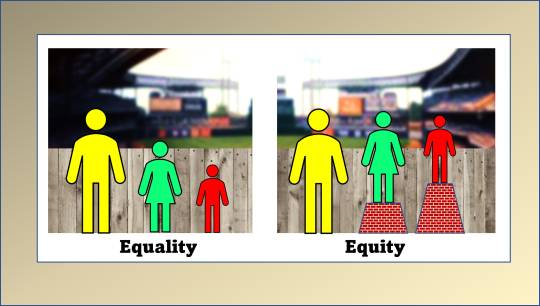
Three people—Mr. Tall, Ms. Medium, and Mr. Short are all trying to watch a baseball game over a fence. On the left, we see the odious world of equality. Mr. Tall has a clear view. Ms. Medium can barely see the field over the fence. Mr. Short cannot see over the fence at all. On the right, in the putatively just world of equity, some Magic Benefactor has allocated a small pedestal to Ms. Medium and a large pedestal to Mr. Short so all three now have equally clear views of the game. To put it another way, “To each according to his needs.”
Problem #1: “Inequality” is labeled “Equality.”
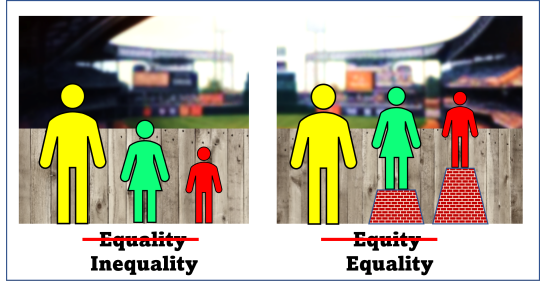
The left-hand picture doesn’t represent “equality.” An egalitarian would say that the left-hand picture represents inequality—an unfortunate but universal aspect of the human condition. The right-hand picture represents equality—a condition to which an egalitarian aspires, fully cognizant that it will never be fully realized. Bad luck, injustice, one’s starting point in life, and one’s own personal choices inevitably lead to some measure of inequality. Siblings of equal intelligence, from the same household, with identical opportunities often end up in vastly different levels of well-being. The Magic Benefactor can allocate all the resources it wants to Fredo, but he’s never going to be Michael.
Problem #2: The meme assumes an omniscient, omnipotent planner.
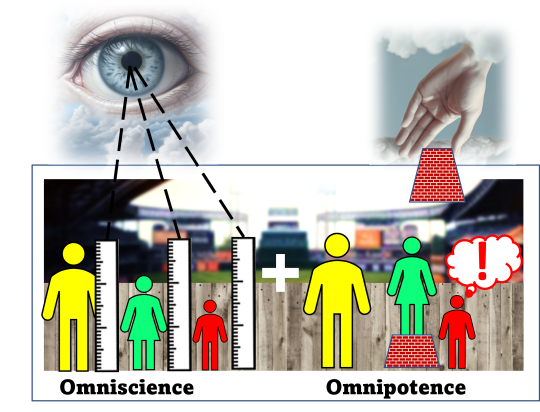
With the Magic Benefactor, individuals are helpless, passive beings, devoid of agency. Under equality, an individual is “given” resources and opportunities. Under equity, some unspecified being “allocates” resources and opportunities. In fact, these unnamed allocators are so perceptive and so powerful that they can allocate “the exact resources and opportunities needed to reach an equal outcome.” This is no Book of Job or Leibniz theodicy problem—where bad things happen to good people. Rather, it is Candide, where Dr. Pangloss always proclaims this to be the best of all possible worlds.
Problem #3: Redistribution can fail or make things worse.
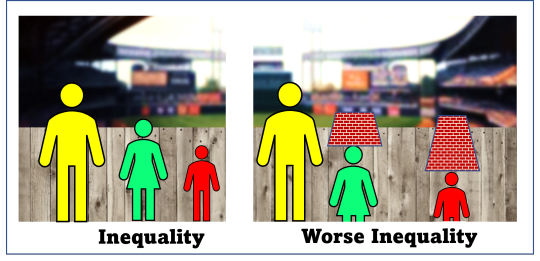
The past century was littered with redistributive schemes designed to achieve equality of outcomes and which ended in failures. There are monstrous cases, like China’s Cultural Revolution. But also benign cases, like America’s well-intended, but frustratingly ineffective War on Poverty. Central planning (i.e., allocating “the exact resources and opportunities needed to reach an equal outcome”) has a remarkable history of ineffectiveness and counterproductivity—where sincere effort to improve the lot of those at the bottom ensnares them in a poverty trap.
Problem #4: Maybe the tall guy sinks or leaves.

The Stadium & Fence and the Magic Benefactor ignore the fact that with redistribution, the reallocated resources come not like manna from Heaven, but rather from the pockets of living, breathing humans. A more realistic version of this metaphor would show Mr. Tall sinking as Ms. Medium and Mr. Short rise. Or perhaps Mr. Tall just packs up and moves away—leaving no one to pay for the pedestals for Ms. Medium and Mr. Short. This is known in governance as “eroding the tax base” and in folklore as “killing the goose that laid the golden eggs.” In the 1960s, President Lyndon Johnson’s top economic advisor, Arthur Okun, explained this phenomenon beautifully in terms of a leaky bucket.
Problem #5: Maybe those in charge have their own bigotries.
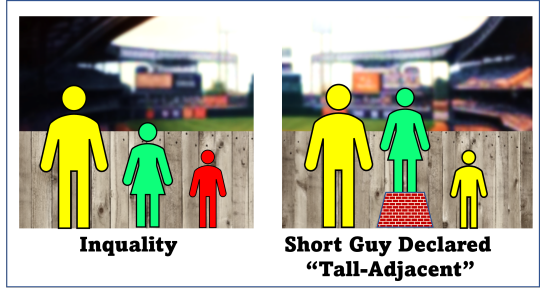
Unlike expert allocators in the Stadium & Fence and the Magic Benefactor, people in charge of real-world redistribution programs are not saintly, unbiased individuals. They come with their own collections of bigotries and deficits of introspection, all reflected in the policies they impose on others. You are disadvantaged only if the elite experts declare that you are disadvantaged. In recent years, for example, Asian-Americans, who suffered terrible discrimination over the course of U.S. history, have been declared by equity “experts” to be “white-adjacent” and, hence, on the losing side of redistribution programs. This reclassification is entirely arbitrary. Coincidentally, the apartheid regime in South Africa implemented a nearly identical redefinition of Japanese, Koreans, and Taiwanese people as “honorary whites”—for entirely cynical reasons.
Problem #6: Maybe the privileged experts in charge just use equity as a pretext to seize more privilege.

One of the more intriguing aspects of the equity agenda is that its proponents effectively say, “Governments, corporations, and educational institutions are hellholes of bigotry and discrimination—so let’s empower governments, corporations, and educational institutions to redistribute resources.” This is popularly known as, “Asking the fox to guard the chicken coop.” It is informative to note the rapidly rising salaries and numbers of equity experts employed by governments, corporations, and educational institutions.
Problem #7: Redistribution focuses on group averages, not individuals.
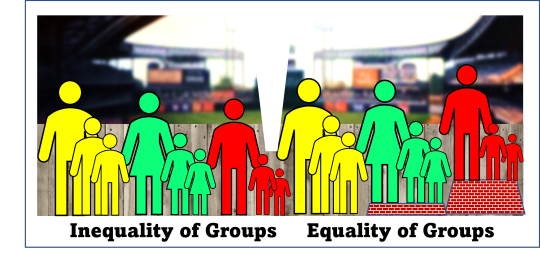
The Stadium & Fence and Magic Benefactor are both stated in terms of individuals, whereas, in reality, policies are applied to broad demographic groups. In this picture, the Talls are taller on average than the Mediums, who are taller on average than the Shorts. But there wide ranges within each category. Equity policies do not aspire to equalize individuals, but, rather, to equalize group averages. So, for example, when the pedestals are “given/allocated” to the Mediums and Shorts, the shortest member of each group, Talls, Mediums, and Shorts, is still unable to see over the fence, whereas the tallest member of the Shorts—who already had a good view of the game—now has an even better view of the game.
Problem #8: Maybe the problem is the fence, not the people.
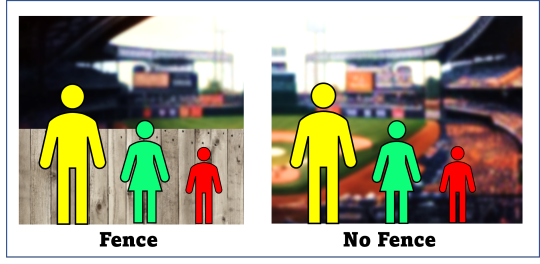
The Stadium & Fence meme never bothers to ask how the obstructive fence got there in the first place. A likely explanation is that the fence was erected by the very people with whom equity experts are entrusting with the task of reallocating resources. Access to healthcare, for example, is often impeded by government regulations that limit the number of doctors, that arbitrarily limit the scope of practice of nurse practitioners, that require hospitals to beg for permission to build new neonatal intensive care units—and enrich established insiders. Rather than obsessing over group averages on health, income, education, etc., perhaps the better approach is to rip down the obstacles that self-interested or misinformed bureaucrats and politicians and others have imposed on others.
Problem #9: Maybe the whole fence analogy is deceptive and elitist.

Finally, few, if any, have asked an obvious question that the Stadium & Fence metaphor begs: ”Why are we obsessing over equalizing viewing by three people trying to watch the game from outside the stadium?” There are two possible reasons why these three are where they are, struggling with the fence, rather than enjoying hot dogs in the bleachers with tens of thousands of other people. First, they may be victims of discrimination—excluded somehow from the stadium. If that’s the case, then equity experts are effectively saying, “It’s fine that these three can’t come into the stadium and sit next to us, but let’s make sure these second-class citizens all get the exact same inferior view of the game from the other side of the fence.” Second, perhaps these three are fully capable of buying tickets to the game but choose, instead, to peer over the fence for free. In which, case, why should anyone worry about how well any of them can steal a view of the game?
==
Unequal outcomes are not inherently unfair.
If the over-the-fence is a medical license, and height is ability to meet the requirements, then those who can't reach the top of the fence shouldn't get to see over it.
If the over-the-fence is entry to Harvard and height is test scores, then those who can't reach the top of the fence shouldn't get into Harvard. And yet, that's exactly what happened.
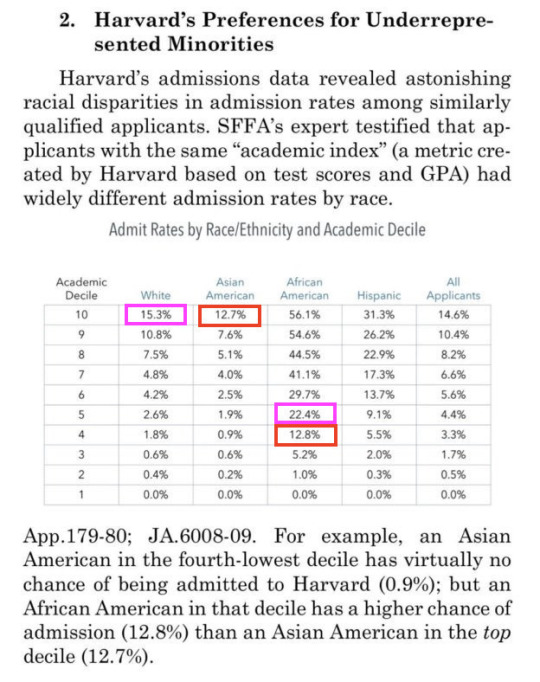
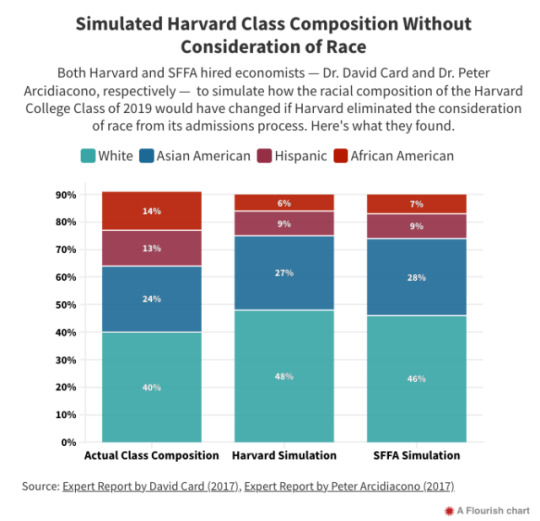
#Robert F. Graboyes#equity#equitism#equitists#equality#equality vs equity#equity vs equality#diversity equity and inclusion#DEI#DEI bureaucracy#stadium and fence meme#religion is a mental illness
9 notes
·
View notes
Photo

Small Business News 8-17-17
0 notes
Text
By: Robert F. Graboyes
Published: Jan 28, 2024
On this, the 79th anniversary of the liberation of Auschwitz, the Holocaust Remembrance industry stands as a colossal failure. Holocaust Remembrance Day, it turns out, successfully transfixed eyes on the rear-view mirror and diverted attention from the dangers 10 feet in front of us. And, truth be told, the rear-view mirror is growing a bit foggy, as well. Less than a century ago, the leading intellectuals of Germany—the most highly educated nation on earth—initiated, participated in, or acquiesced to mass murder on a previously unimaginable scale. And only weeks ago, intellectuals in America, Europe, and elsewhere waxed lyrical over the rape, torture, mutilation, murder, beheading, and kidnapping of innocent Jews.
An important parallel underlies both historical episodes. Both Hitler and Hamas were the cancerous outgrowths of respectable and sometimes altruistic intellectual movements that saw individuals as nothing more than avatars of demographic groups, defined by immutable characteristics. At my own Substack, Bastiat’s Window, I’ve written of this in “The Briar and the Rose,” “Intellectual Tyrants Beget True Believers,” and “Zola, Weiss, and J'Accuse...! 2023.”
A century ago, eugenics provided the unquestioned and unquestionable foundation for academic writing and public policy. Eugenics preached a world of predestination, where an individual’s worth was irrevocably determined at birth by race, religion, gender, sexuality, disability, economic status, and family history. No one could escape his or her essentialist destiny by dint of action, accomplishment, or character. Eugenics began as parlor conversation among well-born, well-educated, often well-meaning British academics. Then, it jumped the Atlantic and gave rise to a sexual sterilization machine in America—enabled by a debauched Supreme Court. Finally, it leaped back to Europe, where it metastasized into the Holocaust.
In our time, the equivalent academic tendency is one that travels under many names—diversity, equity, and inclusion (DEI); critical race theory (CRT); antiracism; white fragility; intersectionality; social justice; anticolonialism; social and emotional learning; progressivism; safetyism; critical social justice; identity Marxism; and (primarily to its denigrators) “wokeness.” The central connective tenet in all of this is something called “equity”—which does not in any way resemble any traditional definition of the word.
A note on nomenclature: “equitism”
Writers like Thomas Klingenstein on the right, Freddie DeBoer on the left, and Bari Weiss in the center decry the lack of a consistent name for this intellectual and activist movement. I use the term “equitism” here and suggest it to others. Unlike “equity,” “equitism” offers no ambiguity of meaning. Unlike, say “the equity agenda,” “equitism” is a single word. Advocates of this philosophy often present “equity” as a substitute for “equality,” so “equitism” is parallel to “egalitarianism.” Unlike “woke,” “equitism” is not an insult or pejorative, and the web shows that a few advocates have used the term to describe themselves. I’ll use the term below for simplicity and clarity.
Equitism as echo of eugenics
Like eugenics a century earlier, equitism presumes that demography is destiny, with some demographic groups imperiled by the immutable malignities of other groups. This often manifests itself as a Manichaean “oppressor/oppressed” dichotomy across demographic categories. Intersectionality and other frameworks array groups along a spectrum between these polar opposites. In its most extreme manifestation, this weltanschauung justifies horrific punishment of perceived “oppressors.” Hence, the pro-Hamas marchers proclaiming “by any means necessary”—which presumably includes baking babies to death in ovens, tying parents to children and immolating them together, raping young girls till their pelvises shatter, beheading children in front of their parents, and visiting all manner of depravities upon elderly Holocaust survivors—as long as they are Israelis and Israelis are classified as oppressors.
Clearly, those Western professors celebrating Hamas have not absorbed whatever lessons that Holocaust Museums were designed to impart. To name one category of protestors, LGBTQ+ Jews marching for Hamas seem not to understand the message of Martin Niemöller. The most enthusiastic practitioners of Holocaust Remembrance, unfortunately, seem to be the members of Hamas, who learned the lessons of those years all too well. It should noted that David Patterson’s 2022 scholarly work, Judaism, Antisemitism, and Holocaust: Making the Connections, documents Hamas’s literal organizational and philosophical links to Hitler’s Nazis.
The central feature of both the Holocaust and of Hamas’s slaughter is that once one abandons the sanctity of individuals and considers only the presumed virtues and vices of demographic groups, one is free to attack those deemed unvirtuous in any way.
Furthermore, equitism, like eugenics, can anesthetize those who do not share the murderous intentions of the Nazis or Hamas. The United States Holocaust Memorial Museum has been open for 31 years, but its mission clearly failed to educate the Ivy League presidents who hemmed and hawed and equivocated over questions of whether calls for genocide against Jews qualified as protected speech on the same campuses where subjectively discerned microaggressions or misuse of preferred pronouns are grounds for ostracism and punishment.
Who wants to contradict something called “social justice” or “diversity” or “equity?” The anesthetic effect seems to have impacted even the Holocaust museums themselves. At Commentary magazine, Seth Mandel asked, “Why Are Holocaust Museums Cowering in Silence?”
Corrosion begins in microscopic proportions
The most important lesson for Holocaust Remembrance comes from Dr. Leo Alexander’s simple, chilling statement that “corrosion begins in microscopic proportions.” Alexander, an American psychiatrist, neurologist, educator, and author, of Austrian-Jewish origin, was a key medical advisor during the Nuremberg Trials. He wrote part of the Nuremberg Code, which provides legal and ethical principles for scientific experiment on humans, and discovered that German doctors didn’t fail to stop the Nazis’ program of genocide and barbaric medical experimentation. Rather, he discovered they didn’t do more to stop the horrors because they were instrumental in initiating them. In a 2018 article on this subject, I argued that:
German doctors enthusiastically volunteered for [service] to, and leadership within, the Third Reich. Deputy Fuhrer Rudolf Hess declared Nazism ‘nothing but applied biology,’ and many German doctors apparently agreed.” Collectively, they decided that medicine’s primary purpose was to build “an economically productive populace,” a concept that “opened the floodgates for atrocities.”
By contrast, Alexander found that Dutch physicians following the Nazi conquest of the Netherlands, unanimously rejected this assumption and viewed their role as healing and comforting the sick and dying. Even when threatened with punishment and death, “humility assured that no Dutch doctors participated in the Holocaust.
German doctors, besotted with eugenics, gladly segmented society by ethnicity, by disabilities, by sexuality, and so forth. And once they began thinking of groups (e.g., productive versus nonproductive races), rather than of individuals, then they were free to commit atrocities in good conscience—or at least to acquiesce in the atrocities committed by others. The same dynamic plays out today on the campuses of America or the streets of London and Paris and Sydney.
Alexander’s work is described in James A. Maccaro’s brief 1997 article “From Small Beginnings: The Road to Genocide.” Alexander’s full paper is his 1948 New England Journal of Medicine report on “Medical Science Under Dictatorship.” A century ago, the oxidants that began society’s corrosion lay in eugenics. Today, the oxidants lie in equitism.
In the early 20th century, eugenics was almost universally accepted by academicians, politicians, doctors, the general public, and celebrities. Opposing eugenics put one’s career and friendships in peril. One of the few public intellectuals to oppose this madness was the British writer G. K. Chesterton, author of Eugenics and Other Evils (1922). Chesterton understood better than anyone that evil comes most often not from evil people, but rather from good people with unmoored ethics. In 1908, he wrote:
The modern world is not evil; in some ways the modern world is far too good. It is full of wild and wasted virtues. When a religious scheme is shattered (as Christianity was shattered at the Reformation), it is not merely the vices that are let loose. The vices are, indeed, let loose, and they wander and do damage. But the virtues are let loose also; and the virtues wander more wildly, and the virtues do more terrible damage. The modern world is full of the old Christian virtues gone mad. The virtues have gone mad because they have been isolated from each other and are wandering alone. Thus some scientists care for truth; and their truth is pitiless. Thus some humanitarians only care for pity; and their pity (I am sorry to say) is often untruthful.
Holocaust Remembrance Day is a worthy project, but not if it is solely backward-looking. Looking for Nazis in 2024 is a futile endeavor. Scanning the horizon in front of us for those with parallel intent is far more urgent and challenging.
As goes the aphorism, “History doesn’t repeat itself, but it rhymes.”
#Holocaust Remembrance Day#Holocaust Memorial Day#Holocaust Remembrance#Auschwitz#Robert F. Graboyes#antisemitism#equitism#woke#wokeness#wokeism#cult of woke#wokeness as religion#Substitution Hypothesis#eugenics#Third Reich#religion is a mental illness#International Holocaust Remembrance Day
7 notes
·
View notes
Text
By: Robert F. Graboyes
Published: Feb 28, 2024
Egalitarianism vs Who-Knows-What
The titanic social struggle of our era pits those favoring equality (in its traditional sense) against those demanding “equity” (in a sense far from its traditional meaning). One who advocates equality is an egalitarian, and his philosophy is egalitarianism. One who advocates “equity” has no name—or has scores of names; the same is true of his philosophy. This asymmetry of nomenclature and the divergent meanings of “equity” put egalitarians at a powerful rhetorical disadvantage. For effective argumentation, egalitarians need to level the rhetorical playing field, and I believe the most efficient way of doing so is to refer to anti-egalitarians as “equitists” and to their philosophy as “equitism”—as we’ll do here.
Following is an excellent example of how equitists themselves distinguish egalitarianism from equitism:
“Equality means each individual or group of people is given the same resources or opportunities. Equity recognizes that each person has different circumstances and allocates the exact resources and opportunities needed to reach an equal outcome.”
Egalitarians aspire to equalize individual rights and opportunities, and perhaps to equalize ex post outcomes across individuals via social safety nets. Equitists, well-intentioned though they may be, pigeonhole people by immutable characteristics (race, gender, sexual orientation, nationality, religion, disability, etc.) and then seek to equalize average outcomes across groups. Someone in charge (an equitist, naturally) must devise a taxonomy of mankind, assign every individual to some cell in that taxonomy, rank each cell along something like an oppressor/oppressed spectrum, and then allocate rights, privileges, opportunities, and wealth among these cells.
Generally, egalitarians seek to define “equal” objectively (e.g., equal rights, opportunities, access to education, income), whereas equitism’s definitions of “equal” are subjective. Equitism is largely an outgrowth of Frankfurt School critical theory, which rejects the very notion of objectivity. (My “Equity-toonz: One Meme Is Worth a Thousand Pictures” explores how explanatory memes that equitists often employ can mislead readers—intentionally or not.)
The subjectivity of equitism can be seen in “antiracism” guru Ibram X. Kendi’s prescription:
“The only remedy to racist discrimination is antiracist discrimination. The only remedy to past discrimination is present discrimination. The only remedy to present discrimination is future discrimination.”
In Kendi’s formulation, no metric can ever signal that equality (between groups) has arrived. Instead, there is never-ending retribution for ancestral sins, subjectively administered via an authoritarian “antiracist constitutional amendment.”
And yet, as odious as Kendi’s ideas may be, the absence of a word like “equitism” leaves egalitarians flailing. Kendi calls his version of equitism “antiracism,” allowing his enthusiasts to declare that if one is not antiracist, then logic dictates that one must be proracist. This false dichotomy forces egalitarians into convoluted, never-satisfying rebuttals. Declaring one’s opposition to “Kendian Equitism” would present no equivalent difficulties.
And “antiracism” is only one of many names an egalitarian must battle. As the artwork atop this essay shows, these interconnected doctrines have been called antiracism; wokeness; diversity, equity, and inclusion (DEI); critical race theory (CRT); environmental, social, and governance (ESG); postcolonialism; anticolonialism; social and emotional learning (SEL); safetyism; intersectionality; oppressor/oppressed; white fragility; identity Marxism; identity politics; fighting white privilege; postmodernism; identity synthesis; social justice; critical social justice; political correctness; progressivism; and more. All are closely related, but just different enough to sow confusion, accidentally or deliberately—e.g., “Antiracism is not the same thing as critical race theory, which is not the same as DEI.”
Sun Tzu said, “He who occupies the high ground will fight to advantage.” The absence of an umbrella term for these highly interrelated philosophies hands equitists the rhetorical high ground. The key to cleaning this Augean Stable of lexicon is recognizing that the revisionist definition of “equity” is the one common thread running through every one of these movements or concepts. This simple trio of terms—equity, equitist, equitism—can level that battlefield of ideas.
-
Name the Target, Freeze It, Personalize It
Many have commented on the absence or multiplicity of names for this anti-egalitarian tendency—and the rhetorical mire this shortcoming imposes on the whole egalitarianism-versus-whatever-you-happen-to-call-it-on-a-given-day debate. On the political right, Thomas Klingenstein said, “Rhetorically, our side is getting absolutely murdered … We have not even come up with an agreed-on name for the enemy.” In the center, Bari Weiss said, “[T]his new ideology doesn’t even like to be named.” On the left, Freddie DeBoer titled an essay (without asterisks), “Please Just F***ing Tell Me What Term I Am Allowed to Use for the Sweeping Political Changes You Demand,” adding, “You don't get to insist that no one talks about your political project and it's weak and pathetic that you think you do.”
Many have suggested names, but none has caught on. This is because an effective name must meet seven separate criteria—and no previously suggested options have checked all or even most of the seven boxes. Here are (1) the criteria; (2) examples of why current terms fail; and (3) why equity-equitist-equitism could succeed.
[1] FLEXIBILITY: There must be a trio of terms naming the aspiration, the advocate, and the philosophy.
If you call the philosophy “wokeness,” then who advocates it? Wokesters? Woke folk? Persons of the woke persuasion? They have no name.
With equity-equitist-equitism, one can say, “Someone who supports equity over equality is an equitist, and his philosophy is equitism.” All grammatical forms are available, and their interconnections are logical and intuitive.
[2] BREVITY: The trio must consist of simple, single, clearly related words.
“Critical race theory” demands three words and seven clunky syllables. Who is its advocate? “Critical race theorist” might describe academicians, but not activists. “Someone who subscribes to critical race theory” entails a mind-numbing seven words and thirteen syllables. “CRT” is brief but obscure.
In contrast, one can easily say, “He is an equitist,” rather than ponderous phrases like, “He is someone who supports the idea of equity over equality,” or the audience-euthanizing, “He is someone who supports equity, but I’m talking about the modern anti-egalitarian definition of equity, not the traditional definition.”
[3] BREADTH: The terms must be applicable to a broad swath of the many allied movements comprising this philosophy.
Enthusiasts swear (sometimes) that CRT is only a legal doctrine and not, say, the clearly derivative concepts taught in K-12 settings. ESG applies only to business investment. You need a term that covers all these related doctrines.
The re-engineered definition of “equity” is the common thread that connects all 21 movements listed above (along with others), and equitist-equitism follow suit. Does any other word fill this niche?
[4] COHESION: The quest for breadth must be offset by parameters that limit the philosophy to a focused topical range.
“Political correctness” may cover many equity doctrines, but it also incorporates lots of barely related concepts—etiquette, scientific doctrines, etc. Maybe SEL derives from postcolonialism, but applying the latter label to the former would likely stall the speaker in a futile argument over arcane lexical points.
Using equity-equitist-equitism limits the conversation to the notion of allocating rights, privileges, resources, and wealth across groups rather than across individuals. It leaves cultural tics and attitudes to other days.
[5] CLARITY: The trio must be sufficiently novel to insulate egalitarians from both innocent confusion and deliberate shenanigans.
To naive listeners, “I oppose Diversity, Equity, and Inclusion” (the doctrine) sounds exactly like “I oppose diversity, equity, and inclusion” (three separate, benign ideals). This can lead to confusion among thoughtful, well-intentioned listeners and speakers—and it allows some disingenuous “equity” enthusiasts to frustrate meaningful debate by means of motte-and-bailey rhetorical tactics (i.e., using a term that has two meanings—one controversial, and one not).
Equity-equitist-equitism quashes the motte-and-bailey problem. “Equitist” and “equitism” have no familiar, traditional meanings with which they can be easily confused—accidentally or purposefully. The word “equity” remains a problem, but one easily dealt with via scare quotes or quick clarifications like “equity, in the equitist sense.”
[6] FAMILIARITY: The trio must not be so novel as to be incomprehensible to those hearing them for the first time.
Yascha Mounk suggests that these doctrines be referred to together as, “identity synthesis.” But one would need a fairly comprehensive explanation before using such an expression. Terminology, like iPhones, should be usable without requiring an instruction booklet.
Someone who has never heard the terms equitist or equitism can intuitively sense their meanings by thinking about the obvious root word—equity.
[7] RESPECTABILITY: The terms must not be patently frivolous or insulting.
“Wokeness” is widely viewed as an insult and, to be honest, the word is usually invoked specifically to deliver scorn or insult. Yes, “woke” was once a self-description that seems to have originated with blues musician Huddie Ledbetter (a.k.a., Lead Belly), but there is always danger in outsiders trying to co-opt in-group slang.
“Equitist” and “equitism” have a staid, neutral vibe. Equity-equitist-equitism is precisely analogous to equality-egalitarian-egalitarianism. While some equitists will object to being called equitists, their complaint will seem more petty and unreasonable than their current objections to “wokeness” or “political correctness.”
Equity-equitist-equitism has an additional bonus virtue. Google Translate is able to translate all three into at least some other languages. (e.g., Equidad-equitista-equitismo for Spanish; Equité-equitiste-equitisme for French). Since these doctrines are debated internationally, this multilingual flexibility is important. This brings us to the following.
-
Equity-Equitist-Equitism as Self Description
Interestingly, one can find some (obscure) equitists on the Internet who have suggested calling their philosophy “equitism.” Billionaire entrepreneur Marc Lore aspires to build a visionary city (“Telosa”) based on a somewhat-related concept of “equitism;” Telosa’s website says, “Equitism is inclusive growth,” and speaks of the project’s “commitment to DEI” to be administered by a municipal DEI department. A group calling itself the Atlas Movement (of whom I know nothing) wrote:
“Equitism is the political, social, and economic doctrine promoting the idea that to maximize peoples’ well-being, society must ensure equitable rights and opportunities for all. In short, we want to systematically improve society by applying the value of Equity (from Aequitas, justice & fairness) to all its areas.”
There was also a 2022 opinion column in Ecuador’s El Heraldo: “La filosofía del equitismo” (“The Philosophy of Equitism”). Written by Guillermo Tapia Nicola, who calls himself a legal and political advisor to Ecuador’s National Assembly, here are some relevant passages (translated from Spanish):
“This endeavor … the result of everything that has happened in recent decades, is what has been called ‘Equitism,’ conceptualizing it as a new ideology for a new stage, which is supposed to guide political and social work. ... Then, talking about democratic equity, equity in vaccines, institutional equity, climate equity, or equity in matters of rights, and verifying the actions that are actually taking place on these issues, will no longer sound strange to the ears ... Ultimately, the effort and determination put in by those agents of change, promoters of equitism, could well give us a spark of hope, two years after the pandemic ... In short, it is about maintaining the audacity of those actions that provide balance, and it is only matched by the audacity of that new vision and philosophy. Equitism.”
I agree with these writers. The movement they describe should have a name, acceptable to honorable advocates and adversaries alike, and I believe the best option lies in equity-equitist-equitism.” Apply these words to the proponents of “equity” and to their philosophy, and let the real debates begin—on level ground, at last.
#Robert F. Graboyes#equity#equality#equity vs equality#equality vs equity#equitist#equitism#egalitarianism#DEI#diversity equity and inclusion#DEI bureaucracy#religion is a mental illness
3 notes
·
View notes